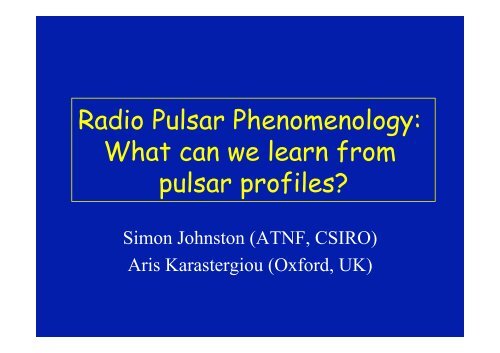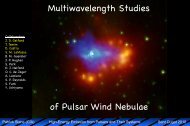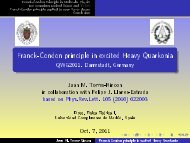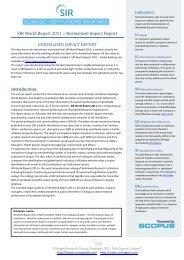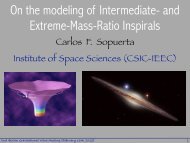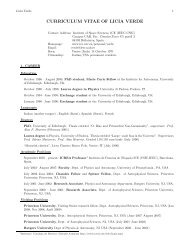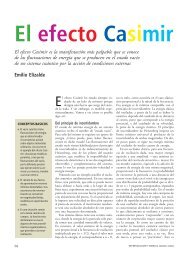Radio Pulsar Phenomenology: What can we learn from pulsar profiles?
Radio Pulsar Phenomenology: What can we learn from pulsar profiles?
Radio Pulsar Phenomenology: What can we learn from pulsar profiles?
You also want an ePaper? Increase the reach of your titles
YUMPU automatically turns print PDFs into web optimized ePapers that Google loves.
<strong>Radio</strong> <strong>Pulsar</strong> <strong>Phenomenology</strong>:<strong>What</strong> <strong>can</strong> <strong>we</strong> <strong>learn</strong> <strong>from</strong><strong>pulsar</strong> <strong>profiles</strong>?Simon Johnston (ATNF, CSIRO)Aris Karastergiou (Oxford, UK)
Outline• Brief tour through the basics• P-Pdot diagram• The Rotating Vector Model– Obtaining <strong>pulsar</strong> geometry• <strong>What</strong> <strong>we</strong>’ve <strong>learn</strong>ed <strong>from</strong> integrated <strong>profiles</strong>– Beam models• Thoughts
Basic Observables and Derivables. I.Measurespin period, P, and its derivatives, dP/dt etcDeriveSpin down energy: Edot = 4π 2 I Pdot/P 3Magnetic Field: B = 3.2×10 19 √(P Pdot) Braking index: n = νν/ν 2Characteristic Age: τ c = Pdot / (n-1)PLight cylinder radius: R lc = 4.77×10 4 P
Basic Observables and Derivables. II.MeasureDM, RM, Tscatt, HI absorptionDeriveInterstellar medium densityInterstellar medium magnetic fieldInterstellar medium turbulence<strong>Pulsar</strong> distances Global picture of Galaxy structure
Basic Observables and Derivables. II.MeasureDM, RM, TscattJohnston et al. 2005Loehmer et al. 2004Image: Reiner Beck
Basic Observables and Derivables. III.MeasurePulse arrival times, glitch parameters,timing noise, binary parametersDeriveTests of general relativityDetection of gravitational waves<strong>Pulsar</strong> distancesNS interior density profile and structureEquation of state
Kramer et al. 2006Image: NASAVerbiest et al. 2010
Basic Observables and Derivables. IV.Single pulses – an area rich in phenomenologyKarastergiou et al. 2001Weltevrede et al. 2007van Leeu<strong>we</strong>n et al. 2003DeriveEmission physics, emission modelsHankins & Eilek 2007
Basic Observables and Derivables. V.MeasureIntegrated <strong>Pulsar</strong> ProfilesDeriveGeometry, emission heights, beamstructure, emission physics, beam models
Assumptions aboutradio emission• Emission <strong>from</strong> open fieldlines above polar cap• Dipolar magnetic field• Emission <strong>from</strong> near surface• Must be coherent emission(unlike at high energies)Could argue about allthese assumptions!
<strong>Pulsar</strong> geometry and therotating vector modelImportant angles are:α – angle bet<strong>we</strong>en therotation and magnetic axisβ – closest approach of lineof sight to magnetic axisρ – cone opening angleThe RVM uses the PA swing to derive the geometry
The Rotating Vector Model (RVM) for polarization 150 o Longitude
The Rotating Vector Model (RVM) for polarization Longitude
The Rotating Vector Model (RVM) for polarization Longitude
The Rotating Vector Model (RVM) for polarization Longitude
The Rotating Vector Model (RVM) for polarization Longitude
The Rotating Vector Model (RVM) for polarization 90 o Longitude
The Rotating Vector Model (RVM) for polarization Longitude
The Rotating Vector Model (RVM) for polarization Longitude
The Rotating Vector Model (RVM) for polarization Longitude
The Rotating Vector Model (RVM) for polarization Longitude
The Rotating Vector Model (RVM) for polarization Longitude
The Rotating Vector Model (RVM) for polarization 30 o Longitude
α = 30, β = -1.7α = 86, β = -3.2RVM fit inalpha-betaspace
α = 30, β = -1.7α = 86, β = -3.2Ambiguity due to restrictedlongitude range!!
RVM is a useful tooland geometry iscrucial for testingmodels of γ-rayemission (and radioemission). In practice,hard to constrain.This PA swing is “forbidden” by the RVM, and is likelythe result of magnetospheric or propagation effects.
Mapping the magnetosphere• We <strong>can</strong> use the radio observations to make a3D map of the emission zones– Need geometry– Need a method of computing altitudes– Need a large sample of <strong>pulsar</strong>s• BUT– Geometry often uncertain– Conflicting results <strong>from</strong> altitude derivations• Models of the beam
Beam modelsof Rankindeveloped in aseries ofpapers since1983.In a nutshell: Two different types of emission, <strong>from</strong>the “core” and <strong>from</strong> “cones”. Emission heights aretypically 300 km at 1 GHz. Circular polarization signchange in the core. Elliptical beams.
Beam modelof Lyne &ManchesterIn a nutshell: No distinction bet<strong>we</strong>en “core” and“cone” emission. Patchy beams with randomemission locations. Circular beams.
Emission heightversus longitude<strong>from</strong> Gangadhara& GuptaIn a nutshell: Emission far <strong>from</strong> the centre occurs athigher heights than emission <strong>from</strong> the centre at agiven observing frequency.
Young <strong>pulsar</strong>study ofJohnston &WeisbergIn a nutshell: Highly polarized, double component(simple) <strong>pulsar</strong>s with high emission heights. Somehave large widths.
Linear polarization fraction versus EdotWeltevrede &Johnston showthat Edot is acrucialparameter!Abrupt transition bet<strong>we</strong>en<strong>from</strong> low to high polarizationstates around Edot of 10 34.5 .No orthogonal mode jumps. Onemode dominates but this is split50:50 bet<strong>we</strong>en parallel andorthogonal modes!!
Polarization and the P-Pdot diagramWeltevrede & Johnston 2008Harding et al. 2002Links with high energy slot-gap models??
Pulse width versus EdotOrthogonal rotatorsHigh Edot, widebeam single poleLow Edotaligned rotatorsWeltevrede &Johnston studyof interpulse<strong>pulsar</strong>s.In a nutshell: Random orientation of B-Ω axis atbirth, becoming aligned over time.
Orthogonal RotatorsWeltevrede & Wright 2009Kramer & Johnston 2008Beam mapping of B0906-49 (left) and B1055-52(above) following RVM fits. Emission heights similarabove both poles. Evidence for emission <strong>from</strong> theclosed field lines (see also Keith et al. 2010).
Beam model ofKarastergiou &JohnstonHigh EdotLow EdotIn a nutshell: High single emission height for highEdot <strong>pulsar</strong>s, multiple heights for low Edot <strong>pulsar</strong>s.Explains high beaming fraction of high Edot <strong>pulsar</strong>s.
Summary• The integrated <strong>profiles</strong> give information on– Geometry, emission heights, the static magnetosphere• Beam models and observations tell us– Clear evidence of conal emission, beam is patchy, emission heightvaries across polar cap• High Edot (non MSP) <strong>pulsar</strong>s– Highly polarized, <strong>from</strong> high emission heights, implying a highbeaming fraction– Geometry poorly constrained in most cases.– Distances are poorly known (until the SKA?)– Often (always?) γ-ray emitters• MSPs– Polarization low– Better handle on (low DM) distances
Questions• <strong>What</strong> is the radio/gamma beaming fraction?– For young, high Edot <strong>pulsar</strong>s?– For MSPs?• Is there a link bet<strong>we</strong>en the radio and the γ-ray apart<strong>from</strong> geometric considerations?– Locations of the emission regions?– Why so many γ-ray MSPs?• <strong>What</strong> do the orthogonal rotators tell us?– Very <strong>we</strong>ll determined geometry– “known” radio emission regions


